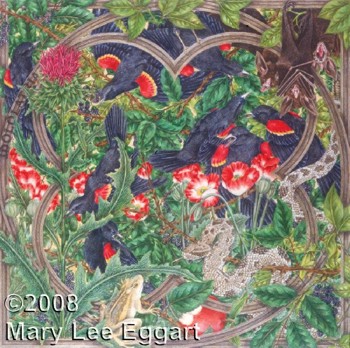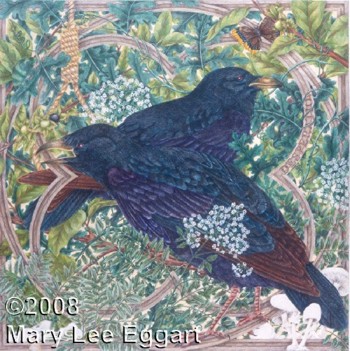Allergories of Virtue and Vice
colored pencil and watercolor
18” x 18"
2003
I first experienced Giotto’s incredible frescos in the Scrovegni Chapel in Padua nearly ten years ago. I was captivated by the vignettes of Virtues and Vices he created below the scenes of the lives of Christ and the Blessed Virgin. I began formulating my own allegorical cycle, using birds as the personifications of the good and evil traits. I relied on both traditional iconographic references and my personal observations of bird behavior when choosing the representative characters. Accompanying each virtue and vice are appropriate symbolic flora and fauna derived from classical and medieval sources. |
| |
|

|
FAITH
The eagle is a symbol of the divine in many faiths and cultures. In The Pilgrimage Samuel Chew wrote, “The eagle pulls the chariot of faith.”
The oak tree, because of its solidity and endurance, represents the strength of faith. The nasturtium, with its helmet-shaped lowers, indicates faith’s protection of the head and mind against false doctrine. Ivy represents clinging to faith as the plant clings to a wall. Shells have long been symbols of the pilgrim, traveler on the road of faith. Firespike plants and sara orange tip butterflies represent the flame of faith that illuminates the mind.
|
|
|
IDOLATRY
Idolatry is the turning away from the truth of faith to the idols of sin. Blackbirds have long been associated with evil and death. Their black feathers represent darkness while their melodious song embodies the lure of sin that turns one away from faith.
The snake, here a diamond-backed rattler, was, in Genesis, the first to tempt humanity with the attractions of sin. Bats, creatures of the night, represent spiritual darkness. Grasshoppers were considered a scourge by farmers and were one of the plagues visited upon Egypt in Exodus.
A blackberry bramble with its thorns suggests the snare of sin. Thistles represent straying from the path of virtue. The narcotic effect of poppies implies a lack of vigilance, a refusal to see the truth. Poison ivy represents the insidious nature of sin. |
| |
|
|

|
HOPE
The rooster greeting the dawn represents the hope of the new day.
Hope of the return of Spring is symbolized by the swallow. Eggs and the metamorphosizing monarch butterflies represent the hope of renewed life. Pomegranates, originally a pagan symbol of vernal rejuvenation of the earth, became a Christian symbol of the hope of everlasting life.
The bitter herb wormwood became of symbol of hope from the Italian proverb: “Hope is a kind of honey blended with wormwood.” In hope there is always the sweetness of expectation mixed with the bitterness of uncertainty.
The rainbow trout stands in for the rainbow that appeared after the Genesis flood giving hope of renewed life to humanity.
|
|
|
DESPAIR
The raven has always been seen as a foreteller of doom: most famously, Poe’s raven proclaimed: “Nevermore.” Noah sent out a raven to look for dry land after the flood and it did not return.
Suicide, the ultimate expression of despair, is represented by the noose, and the fatally poisonous hemlock and avenging angel mushrooms.
Death is symbolized by the bird skulls, mourning cloak butterfly, and the wild gourds with their bitter taste. The broken egg evokes lost hope.
|
| |
|
|
CHARITY
Designated by Christ as the greatest virtue, charity is not merely almsgiving, but requires love of neighbor.
Ancient legends describe the pelican as feeding her young with blood drawn from her own breast. Accordingly, the pelican became a sign of Christ’s limitless love for human souls and the gift of his own blood.
Traditional symbols of Christian love are the red rose, plum, bleeding hearts, ivy and caladiums with their heart-shaped leaves. The red-hot poker plant corresponds to the flame of love.
The legend of the robin’s charity says that the robin tried to relieve Christ’s suffering on the cross by plucking thorns from the crown of thorns on his head. Christ’s blood stained its breast red forever. |
|
|
AVARICE
The vice of greed is represented by the magpie, a pilfering bird that robs other birds’ nests and is fond of bright, shiny objects.
Greed often manifests itself as a desire for wealth and the power it buys, signified by dollarweed and moneywort plants and the New Year’s Day black-eyed peas and cabbage.
The buckthorn tree, an invasive plant with cruel thorns, represents the avaricious man who tears apart the lives of the poor.
A greedy pig waits in the bushes for the squabbling magpies to drop their gold coin.
|
| |
|
|
|
HUMILITY
Humility was attributed to the skylark because it lives quietly in the fields and only sings when it is high in the sky, alone.
Plants that grow in shady or solitary places, or whose flowers and fruits are hidden in foliage, including lily of the valley, Spanish broom, strawberries, violets, and peaches, are traditional symbols of humility.
|
|
|
PRIDE
The ostentatious peacock has long been a symbol of pride and vanity.
The narcissus flower suggests the classical legend of Narcissus who fell in love with his own reflection. All orange lilies, especially the tiger lily, indicate pride and disdain. The trumpet creeper flower represents those who must always blow their own horns. |
| |
|
|
|
PRUDENCE
Described as wisdom in action, prudence is represented by the great horned owl, a traditional symbol of wisdom.
Solomon’s seal flowers evoke the wisdom of the Old Testament king. Hyacinth, crocus and the olive tree are all associated with Apollo and Minerva, classical god and goddess of wisdom. The mulberry tree was described in medieval times as a prudent tree, blooming late, after all danger of frost was gone.
The buckeye butterfly with the “eyes” on its wings signifies all-seeing awareness. |
|
|
FOLLY
A booby is a fool, and it is certainly foolish to have such bright blue feet.
The gourd, like all vines, is in need of support and represents willful ignorance. The pea, which has heavy fruit on a frail stem, epitomizes instability. The reed plant looks deceptively straight and tall, but provides no support to those foolish enough to lean on it.
|
| |
|
|
|
TEMPERANCE
The coot, in the earliest bestiaries, was said to live a life of moderation and thus was an appropriate symbol of temperance.
The myrtle tree, represented here by myrtle warblers, and the beech tree are traditional symbols of the balanced life. The crocus represents abstinence because of its paleness.
Elephants, implied by the elephant ear plants, were described in medieval times as the most temperate of animals, eating only as much as needed to survive.
The purple hairstreak butterfly wears the color purple, said to be the perfect balance of red and blue, and hence a symbol of temperance. |
|
|
GLUTTONY
In Lydgates Pilgrimage of the Life of Man, the character Gluttony says, “Like a bittern, I have two stomachs.” Medieval London was plagued with kites so ravenous that they swooped down to steal food from children.
In the medieval bestiaries, the hedgehog was described as being so greedy that it would gather fallen fruit on its spines by rolling on it. The fruit and grape vines represent Bacchanalian excess.
|
| |
|
|
|
CHASTITY
Swans, with their pure white plumage and tendency to mate for life, have long been symbols of ideal, chaste love.
Representing the fidelity and chastity of married life are peonies, orange blossoms, and lemons, ancient traditional ornaments for weddings and brides. The chestnut is a sign of the chastity of virginity, its fruit surrounded by thorns but unharmed by them.
Medieval monks recommended the ingestion of the herb rue to help maintain a chaste life. |
|
|
LUST
The magnificent frigate bird advertises his desire to mate by inflating a huge balloon-like red sack that stretches from his beak to his breast.
Mushrooms symbolize lust because their pleasing taste often masks a fatal poison. Orchids and chicory were believed to be aphrodisiacs.
|
| |
|
|
DILIGENCE
Always busy, chickadees, nuthatches, wrens, and titmice are appropriate representatives of diligence.
Both in the Bible and Aesop’s fables, ants are endowed with prudence and industry, as is the busy bee. The almond tree, flowering early in the year, was a common symbol of diligence. The cockscomb plant was thought to always be in bloom and never withered. Thyme, considered by medieval gardeners to be a dry and ordinary plant, nevertheless provided bees with nectar for honey, just as arduous tasks can give pleasure and benefit to those who perform them.
|
|
|
SLOTH
The king vulture, like all scavengers, lives on the labor of others rather than killing its own food. The cowbird lays its eggs in the nests of other birds so it does not have to go to the trouble of raising its own young.
Aesop contrasts the industry of the ant with the laziness of the grasshopper. Fiddlehead ferns remind us of the times we fiddle around instead of attending to business. Ivy, which relies on other plants for support, represents the life of a negligent person. Nettles are associated with sloth in the book of Proverbs (24:30-31): “I went by the field of the slothful. . .it was all grown over with thorns and nettles.”
Miss Muriel Minn was a sweet-natured cat, but she was undoubtedly the most idle animal I have ever known. |
| |
|
|
GENTLENESS
The virtue of gentleness is associated with compassion, purity, and patience. The peaceful dove has always been a symbol of loving-kindness. Lamb’s ears plants suggest the gentle lamb.
Daisies, babies’ breath and myrtle have traditionally indicated gentle innocence.
The Grimalkin, was a shy, gentle cat who would have been alarmed to find himself surrounded by so many doves.
|
|
|
ENVY
Because it steals the eggs of other birds, the partridge was regarded as personifying envy.
The foxglove flowers represent the fox in Aesop’s fable who envied the crow’s grapes. The bitter herb wormwood reflects the bitterness of the envious person. Snakes are symbols of envy because envy has a poisonous tongue.
|
| |
©2008 Mary Lee Eggart
All images and text in this site are protected by copyright law and may not be reproduced in whole or part
without the express written permission of the artist.
|
|

